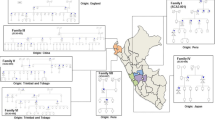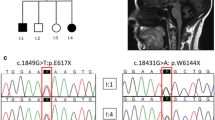Abstract
Diagnostic evaluation of two sisters affected by ataxia, with similar age of onset, revealed a characteristic trinucleotide expansion in the Friedreich’s ataxia (FRDA) locus and two different phenotypic presentations. At onset the elder sister had retained deep tendon reflexes (FARR), while the younger sister presented classic FRDA. The GAA expansion in the patients’ alleles proved to be similar in both siblings, ruling out that age at onset and clinical heterogeneity could be due to different FRDA mutations. On the whole, clinical and genetic data on these patients confirmed that FARR is a variant phenotype of FRDA.
Similar content being viewed by others
Author information
Authors and Affiliations
Corresponding author
Rights and permissions
About this article
Cite this article
Armani, M., Zortea, M., Pastorello, E. et al. Friedreich’s ataxia: clinical heterogeneity in two sisters. Neurol Sci 27, 140–142 (2006). https://doi.org/10.1007/s10072-006-0617-8
Received:
Accepted:
Issue Date:
DOI: https://doi.org/10.1007/s10072-006-0617-8




